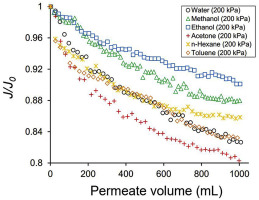当前位置:
X-MOL 学术
›
J. Membr. Sci.
›
论文详情
Our official English website, www.x-mol.net, welcomes your feedback! (Note: you will need to create a separate account there.)
Fouling behavior of colloidal particles in organic solvent ultrafiltration
Journal of Membrane Science ( IF 8.4 ) Pub Date : 2020-04-01 , DOI: 10.1016/j.memsci.2020.117836 Ziqiang Yin , Yunqiao Ma , Begum Tanis-Kanbur , Jia Wei Chew
Journal of Membrane Science ( IF 8.4 ) Pub Date : 2020-04-01 , DOI: 10.1016/j.memsci.2020.117836 Ziqiang Yin , Yunqiao Ma , Begum Tanis-Kanbur , Jia Wei Chew

|
Abstract Membrane technology is increasingly becoming a promising alternative in the chemical and pharmaceutical industries, wherein organic solvents may form the continuous phase. Regarding the inevitable membrane fouling phenomenon, although the knowledge base is rich for feeds involving water, an analogous understanding for feeds involving organic solvents is limited. Accordingly, in this study, we systematically investigated the fouling behaviors of a model colloidal foulant (namely, silica) dispersed in water and five organic solvents (namely, methanol, ethanol, acetone, toluene and hexane) during ultrafiltration. The flux decline trends were clearly different. The XDLVO model and a fouling model were employed to extract mechanistic insights. Firstly, zeta potential alone was a poor indicator of the fouling extent. Secondly, solvents with high polarity (i.e., methanol, ethanol) had repulsive foulant-foulant and foulant-membrane interfacial interactions, which were beneficial in mitigating membrane fouling, leading to lesser flux decline and lower cake resistance. Thirdly, solvents with no or low polarity (i.e., n-hexane, toluene and acetone) had attractive interfacial interactions, which worsened membrane fouling. However, attractive foulant-foulant interaction was beneficial in augmenting shear-induced diffusion, which mitigated fouling. Fourthly, the fouling parameters extracted from the fouling model generally were lesser and greater respectively for the high-polarity and lower-polarity solvents, which agree with the interfacial interaction values and flux decline trends. The insights emanating from this study on membrane fouling in organic solvents are expected to be valuable in the design and operation of such emerging membrane-filtration systems.
中文翻译:

有机溶剂超滤中胶体颗粒的污染行为
摘要 膜技术正日益成为化学和制药行业的一种有前途的替代方法,其中有机溶剂可以形成连续相。关于不可避免的膜污染现象,虽然对涉及水的进料有丰富的知识库,但对涉及有机溶剂的进料的类似理解是有限的。因此,在本研究中,我们系统地研究了分散在水和五种有机溶剂(即甲醇、乙醇、丙酮、甲苯和己烷)中的模型胶体污垢(即二氧化硅)在超滤过程中的污垢行为。通量下降趋势明显不同。XDLVO 模型和污垢模型被用来提取机械见解。首先,单独的 zeta 电位不能很好地指示结垢程度。第二,高极性溶剂(即甲醇、乙醇)具有排斥性污垢-污垢和污垢-膜界面相互作用,这有利于减轻膜污染,导致通量下降较小和滤饼阻力较低。第三,无极性或低极性的溶剂(即正己烷、甲苯和丙酮)具有有吸引力的界面相互作用,这会加剧膜污染。然而,有吸引力的污垢-污垢相互作用有利于增加剪切诱导的扩散,从而减轻污垢。第四,从污垢模型中提取的污垢参数通常对于高极性和低极性溶剂分别较小和较大,这与界面相互作用值和通量下降趋势一致。
更新日期:2020-04-01
中文翻译:

有机溶剂超滤中胶体颗粒的污染行为
摘要 膜技术正日益成为化学和制药行业的一种有前途的替代方法,其中有机溶剂可以形成连续相。关于不可避免的膜污染现象,虽然对涉及水的进料有丰富的知识库,但对涉及有机溶剂的进料的类似理解是有限的。因此,在本研究中,我们系统地研究了分散在水和五种有机溶剂(即甲醇、乙醇、丙酮、甲苯和己烷)中的模型胶体污垢(即二氧化硅)在超滤过程中的污垢行为。通量下降趋势明显不同。XDLVO 模型和污垢模型被用来提取机械见解。首先,单独的 zeta 电位不能很好地指示结垢程度。第二,高极性溶剂(即甲醇、乙醇)具有排斥性污垢-污垢和污垢-膜界面相互作用,这有利于减轻膜污染,导致通量下降较小和滤饼阻力较低。第三,无极性或低极性的溶剂(即正己烷、甲苯和丙酮)具有有吸引力的界面相互作用,这会加剧膜污染。然而,有吸引力的污垢-污垢相互作用有利于增加剪切诱导的扩散,从而减轻污垢。第四,从污垢模型中提取的污垢参数通常对于高极性和低极性溶剂分别较小和较大,这与界面相互作用值和通量下降趋势一致。















































 京公网安备 11010802027423号
京公网安备 11010802027423号